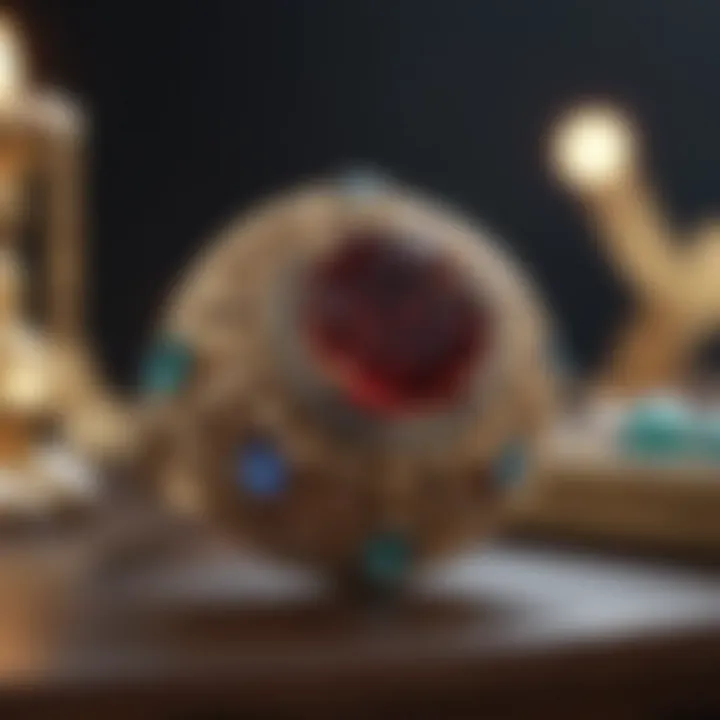Understanding Your Birthstone: A Comprehensive Guide


Intro
The exploration of birthstones invites a rich tapestry of history, personality, and cosmic significance. Each gemstone aligns with a specific month, resonating with unique energies and characteristics that many believe influence individual traits. Understanding your birthstone is not merely a pursuit of aesthetics; it can deepen your connection to your identity and the universe. This guide aims to unfold the various facets of birthstones, offering profound insights for both the novice and the seasoned astrology aficionado.
Zodiac Profiles
Overview of Each Sign
Birthstones are often correlated with the twelve zodiac signs, each sign carrying a distinct celestial significance. The relationship between zodiac signs and birthstones underscores the belief that the month of birth and the position of celestial bodies can shape individual experiences. For example, if you were born under Aries, your stone is the diamond, symbolizing clarity and strength, while those born in the month of Taurus often wear the emerald, known for its associations with harmony and growth.
Personality Traits
Astrology enthusiasts often associate specific personality traits with each zodiac sign, which can be further reflected in their birthstones. Here’s a brief overview:
- Aries (March): Ambitious and energetic; diamonds inspire courage.
- Taurus (April): Practical and reliable; emeralds enhance stability.
- Gemini (May): Curious and adaptable; agate promotes balance.
- Cancer (June): Sensitive and nurturing; moonstone reflects intuition.
- Leo (July): Confident and creative; rubies amplify passion.
- Virgo (August): Analytical and meticulous; peridots promote self-acceptance.
- Libra (September): Diplomatic and romantic; sapphires enhance communication.
- Scorpio (October): Intense and transformative; opals strengthen emotions.
- Sagittarius (November): Adventurous and open-minded; topazes boost creativity.
- Capricorn (December): Disciplined and responsible; turquoise encourages wisdom.
- Aquarius (January): Innovative and eccentric; garnets inspire reflection.
- Pisces (February): Compassionate and artistic; amethysts promote peace.
Strengths and Weaknesses
Understanding the strengths and weaknesses associated with each zodiac sign can provide additional clarity on how birthstones can influence one’s path. The following outlines this dynamic:
- Aries: Strength: Leadership; Weakness: Impulsiveness.
- Taurus: Strength: Determination; Weakness: Stubbornness.
- Gemini: Strength: Communication; Weakness: Inconsistency.
- Cancer: Strength: Emotional depth; Weakness: Moodiness.
- Leo: Strength: Enthusiasm; Weakness: Pride.
- Virgo: Strength: Attention to detail; Weakness: Overcritical.
- Libra: Strength: Fairness; Weakness: Indecision.
- Scorpio: Strength: Resourcefulness; Weakness: Jealousy.
- Sagittarius: Strength: Optimism; Weakness: Restlessness.
- Capricorn: Strength: Reliability; Weakness: Pessimism.
- Aquarius: Strength: Originality; Weakness: Detachment.
- Pisces: Strength: Empathy; Weakness: Escapism.
By recognizing these traits and tendencies, one can better understand the significance of their personal birthstone and its role in daily life.
Understanding your birthstone can encourage personal growth and reflection.
Compatibility Insights
Exploring compatibility through the lens of astrology is a distinctive approach to relationships. Understanding how birthstones interact can offer practical insights into love, friendship, and even workplace dynamics.
Preface to Birthstones
Birthstones hold a significant place in both history and personal identity. They are more than just adornments; they symbolize specific traits and offer an insight into one's character. Understanding birthstones can enhance one’s appreciation for these gems, leading to both personal and spiritual growth.
Historical Background
The practice of associating gemstones with specific months dates back thousands of years, with roots in both Eastern and Western traditions. Ancient civilizations believed that stones not only reflected the personality of a person but also could influence their fate.
In the Bible, the Book of Exodus describes a breastplate worn by Aaron, which contained twelve stones representing the twelve tribes of Israel. This historical connection has bridged cultures and generations, embedding birthstones in societal practices and observations.
Additionally, during the Roman era, it became common to wear certain stones according to one's birth month, believed to enhance one's attributes. Being aware of these historical ties can foster a deeper, more enriching relationship with one's birthstone.
Cultural Significance Across Civilizations
Around the world, birthstones carry diverse meanings. In many cultures, they are seen as talismans for protection, guidance, and prosperity. For instance, in Hindu traditions, certain gems are believed to govern specific planets and are worn to counteract negative astrological influences.
In medieval Europe, birthstones became symbols of membership in certain guilds or religious affiliations, thereby contributing to social identity. Cultures also developed rituals surrounding specific stones, often linking them with health benefits or spiritual clarity.
Such cultural interpretations remind us that these stones are not just beautiful objects but also bear the weight of human experience and aspirations across time and geography.
“Understanding birthstones opens avenues for personal and collective introspection.”
In summary, exploring the background and cultural significance of birthstones deepens our connection with these stones. This journey through history and culture provides a framework to appreciate how birthstones can relate to personal identity and growth.


How to Determine Your Birthstone
Determining your birthstone is both a personal journey and a pathway to understanding the unique significance embedded in these gemstones. In this section, we will explore various means of identification, weaving together both tradition and individual experience. Knowing your birthstone allows for a deeper comprehension of its properties, enhancing your personal connection to it. This understanding can be enlightening and beneficial in various aspects of life, from personal choices to spiritual guidance.
Understanding the Birthstone Calendar
The birthstone calendar serves as a foundational tool designed to assign specific gemstones to each month. This tradition can be traced back to historical practices that connected astrological signs with particular stones. The calendar is not just a set of rules but a reflection of cultural values and beliefs associated with each gemstone. Most calendars feature a list of twelve months, each linked to its corresponding birthstone.
- January: Garnet
- February: Amethyst
- March: Aquamarine
- April: Diamond
- May: Emerald
- June: Pearl and Alexandrite
- July: Ruby
- August: Peridot
- September: Sapphire
- October: Opal and Tourmaline
- November: Topaz and Citrine
- December: Turquoise and Zircon
The significance of the birthstone calendar lies not only in its historical context but also in the personal meaning each stone can hold. When choosing a birthstone based on the calendar, consider not only the month but also what resonates with you personally. Each stone has unique properties and energies that may enhance your life in various ways.
Remember: Your birthstone can serve as a talisman or a source of inspiration in times of uncertainty.
Calculating Birthstones Based on Birth Date
Determining your birthstone can be more precisely tailored by considering your actual birth date. This method allows for a more individualized approach, as some might feel a stronger connection to a different stone within their birth month. To calculate your personal birthstone, examine your specific day within the month and explore alternate stones that may be associated with that date.
For instance, if you were born in April, while diamond is the primary stone, you can also consider secondary stones like white sapphire. It offers both aesthetic allure and can be a more accessible alternative.
In certain traditions, the exact day can further align you with a specific set of energies characteristic of particular gemstones. Therefore, people often choose to delve deeper into the meanings of the stone corresponding to their exact birth date.
Considerations for Determining Your Birthstone
- Explore Multiple Sources: Check different calendars and methods to find what feels right for you.
- Personal Preference: Trust your instincts; the stone’s appearance or energy might resonate more than just its month.
- Consult Spiritual Guidance: Some may prefer to seek advice from astrologers or practitioners who specialize in gemstones.
Understanding how to determine your birthstone involves more than just looking at a calendar. It's about aligning with the energies these stones offer, thereby enhancing your connection and appreciation for them.
January to December: A Month-by-Month Birthstone Guide
The examination of birthstones month by month offers more than just a list of stones. It strains the significance of timing and personal identity within the context of these gems. Each month has a distinct stone aligned with it, revealing layers of history, culture, and personal meaning. Understanding this connection can enhance appreciation and inform decisions related to jewelry, gifts, or even self-care practices.
January: Garnet
Garnet, the January birthstone, is known for its deep red hue yet also appears in varied colors. It symbolizes loyalty and positive energy. Historically, it is believed to provide protection and health to its wearer. This characteristic makes it a popular choice for jewelry adorning both men and women, often chosen for its timeless appeal.
February: Amethyst
Amethyst, with its rich violet flavor, represents calmness and clarity of mind. For ages, it has been closely associated with wisdom and balance. Users believe it can help in meditation, making it a preferred stone for those seeking spiritual enhancement. When worn, it is said to foster inner peace and emotional balance.
March: Aquamarine
Aquamarine offers a serene blue color reminiscent of the ocean. It stands for tranquility and harmony. Traditionally, sailors wore it for good luck. In modern life, it emphasizes stress relief, making it appealing for people in fast-paced environments. Aquamarine jewelry adds a calming presence to any collection.
April: Diamond
April’s diamond is the most famous birthstone, representing strength and eternity. Diamonds are valued not just for their beauty but also for their unrivaled durability. Frequently gifted in engagement rings, they epitomize love and commitment. Beyond romance, diamonds also symbolize clarity, promising a bright future.
May: Emerald


Emerald, with its vibrant green shade, signifies rebirth and growth. It has long been adored for its color and perceived ability to enhance intuition. Many cultures associate it with fertility and hope. Wearing emeralds can offer a sense of rejuvenation, making it a popular choice for special occasions.
June: Pearl and Alexandrite
Pearls embody purity and femininity with their delicate appearance. They are classic yet versatile jewels suitable for various occasions. Alexandrite, on the other hand, is celebrated for its unique color-changing properties. Both stones offer an intriguing duality, appealing to a wide range of personal styles and preferences.
July: Ruby
Ruby, the birthstone of July, is known as the “king of gems.” Its vibrant red tones represent passion and vitality. Associated with love and courage, rubies are often chosen for romantic gifts. They are believed to bring about protection and prosperity, resonating with those who seek strength and vitality in their lives.
August: Peridot
Peridot, shimmering in green hues, symbolizes strength and balance. Historically, it is linked with the sun and believed to ward off negativity. Wearing peridot can promote emotional healing and personal growth. Its unique appearance adds a refreshing touch to any gemstone collection.
September: Sapphire
Sapphire is known for its royal blue shades, representing wisdom and nobility. This stone inspires loyalty and integrity. Many choose sapphires not just for their beauty but also for their historical significance in royal circles. They are often seen as a testament to enduring commitments and long-lasting bonds.
October: Opal and Tourmaline
Opal, showcasing a spectrum of colors, symbolizes creativity and inspiration. It is believed to enhance emotions and promote self-understanding. Tourmaline, known for its variety, represents protection from negative energy. Together, they offer a harmonious blend of creativity and strength, appealing to artists and those seeking personal growth.
November: Topaz and Citrine
Topaz, in its rich golden hue, symbolizes love and affection. It is traditionally linked to good fortune and protection. Citrine, often referred to as the “merchant's stone,” is thought to attract wealth and success. Both stones in November allow fans to celebrate abundance and positive energy in their life.
December: Turquoise and Zircon
Turquoise, with its striking blue-green tones, signifies friendship and peace. It's a stone often used for protective qualities. Zircon, similarly beautiful, symbolizes wisdom and honor. Together, these December gemstones evoke a presence of acceptance and awareness, providing a soothing energy for those who wear them.
Understanding the symbolic significance of each birthstone aligns with a deeper comprehension of personal identity and influence.
Each birthstone's characteristics and meanings draw attention to personal traits, making month-by-month analysis beneficial. It enhances understanding for those interested in astrology or holistic approaches to life.
The Symbolism and Meanings of Birthstones
Birthstones hold a deep significance in various cultures and spiritual practices. Their meanings often extend beyond aesthetics, connecting individuals to their personal identities. Birthstones are believed to carry unique energies that reflect the nature of the person born in a specific month, making them more than just pretty gems. Understanding these meanings can enhance appreciation, enrich self-awareness, and aid in personal growth.
Metaphysical Properties of Birthstones
Metaphysical properties refer to the purported spiritual or healing capabilities of birthstones. Each stone is said to possess characteristics that can impact the wearer’s life positively.
- Energy Healing: Many people use birthstones in energy healing practices. For example, aquamarine is believed to calm nerves and reduce stress, while garnet is regarded for its energizing effects. These properties attract those seeking to alleviate emotional burdens.
- Meditation Aids: Certain birthstones are favored for meditation. Amethyst, for instance, is often included in practices for its potential to promote tranquility and deeper intuition. Incorporating birthstones into meditation can enhance focus and clarity.
- Manifestation Tools: Individuals may carry or wear their birthstones to manifest desires. Many believe that the essence of the stone can align one's intentions with the universe.
Cultural Interpretations of Birthstone Meanings
Different cultures imbue birthstones with unique meanings and significance. These interpretations reflect local traditions and beliefs, adding layers to the understanding of these gemstones.
“The meanings of birthstones evolve with cultural heritage, revealing the bond between people and their stones.”


- Western Traditions: In Western astrology, each birthstone corresponds to a specific month and is associated with particular qualities. For example, the emerald symbolizes love and rebirth in May, while the ruby signifies passion and protection in July.
- Eastern Traditions: In some Eastern cultures, birthstones serve more than personal significance; they are believed to influence overall destiny. For instance, in Hindu culture, gemstones are linked to astrological signs and thought to enhance cosmic luck.
- Historical Beliefs: Throughout history, birthstones were often used in healing remedies, talismans, and religious artifacts. In ancient times, people believed that wearing a birthstone would protect them or bring good fortune.
Understanding the symbolism and meanings of birthstones opens a treasure trove of personal insights, guiding individuals toward self-discovery and fulfillment.
Practical Applications of Your Birthstone
Understanding birthstones goes beyond mere identification; it encompasses their practical applications in daily life. Incorporating these stones can enhance personal style, mediation, and personal connections. Utilizing birthstones can serve not only aesthetic purposes but also offer deeper meaning in personal and social contexts.
Incorporating Birthstones into Jewelry
Birthstones are traditionally set in various types of jewelry, such as rings, necklaces, bracelets, and earrings. Jewelry that features one’s birthstone can create a personal statement while providing a connection to identity and heritage. There are several factors to consider when selecting birthstone jewelry:
- Style: Choose styles that mesh with personal taste, whether modern, vintage, or minimalist.
- Material: Consider the metal type. Gold, silver, and platinum are popular choices.
- Customizations: Personalized options may enhance meaningful connections. One can engrave initials or significant dates.
- Occasions: Jewelry can serve as perfect gifts for birthdays, anniversaries, or as tokens of appreciation.
Wearing birthstone jewelry acts as a daily reminder of one’s unique attributes and qualities. It can also be a conversation starter.
Using Birthstones for Meditation and Healing
Birthstones are often linked with meditative practices and holistic healing. Many people believe that these stones possess metaphysical properties that can facilitate emotional balance and clarity. Incorporating birthstones into meditation can be done in various ways:
- Holding the stone: When meditating, cradling your birthstone can provide focus, assisting with grounding and emotional release.
- Crystal grids: Strategically placing birthstones in a grid can amplify energy, fostering a nurturing environment.
- Visualization: Imagining the stone's energy enveloping you during meditation can enhance relaxation and mental clarity.
Some users report benefits such as reduced anxiety or improved focus from these practices. Therefore, integrating a personal birthstone into daily meditation could be transformative.
Gift-Giving Ideas Centered Around Birthstones
Gift-giving is inherently more thoughtful when approached through personal significance. Birthstones offer unique opportunities for meaningful presents. Here are a few ideas:
- Customized Jewelry: Create personalized items such as birthstone rings or necklaces tailored to the recipient's month.
- Decorative Stones: Raw or polished birthstones can be decorative pieces, adding charm to homes while also providing symbolic value.
- Wellness Kits: Assemble a kit with the birthstone along with related essential oils or candles for relaxation and well-being.
- Personalized Birthstone Charts: Provide a framed chart detailing the meanings and benefits associated with the recipient’s birthstone.
Offering gifts that reflect astrological values not only elevates the tradition but resonates on a deeper emotional level.
Embracing the practical applications of birthstones allows individuals to weave personal narratives into everyday life.
The exploration of practical applications underscores the multi-faceted significance of birthstones. With thoughtful incorporation into jewelry, holistic practices, and the realm of gifting, one can cultivate a meaningful relationship with these unique gems.
The End: Embracing Your Birthstone
Understanding your birthstone can enhance your connection to your personal identity and the larger, cosmic world. Throughout this article, we explored birthstones from historical, cultural, and practical perspectives. Each birthstone is not merely a beautiful stone but represents much more, including qualities that resonate with the individual born in that month.
The Unique Connection to Personal Identity
For many individuals, a birthstone serves as a point of identification. The stone is tied to the month of one's birth, reflecting inherent characteristics. This connection can foster a sense of belonging and help affirm personal traits. For instance, wearing a sapphire might invoke feelings of loyalty and wisdom, reinforcing these traits in one’s personality.
Furthermore, the deep roots of tradition associated with birthstones are also meaningful. Different cultures attribute distinct significance to each stone, which can inspire further exploration of one’s heritage. Becoming aware of this connection often leads to a deeper appreciation of one’s own identity.
"Seeing the connection between one’s birth month and the assigned stone can help individuals embrace the qualities they symbolize."
The Role of Birthstones in Personal Growth
Birthstones also play an important role in personal growth. Each stone is often believed to emit specific energies. Such energies can guide personal development, offering support in various aspects of life—be it emotional, spiritual, or physical. For example, the calming energy of an amethyst may help individuals facing anxiety, while the strength of a ruby could assert confidence during challenging times.
Incorporating birthstones into daily practices can amplify these benefits. Whether through jewelry, meditation, or simply keeping a piece nearby, the intention behind the use of one’s birthstone can foster transformative experiences.
Ultimately, embracing your birthstone is about recognizing its significance not just as a gem, but as a part of your journey towards understanding yourself and evolving authentically within the universe.



